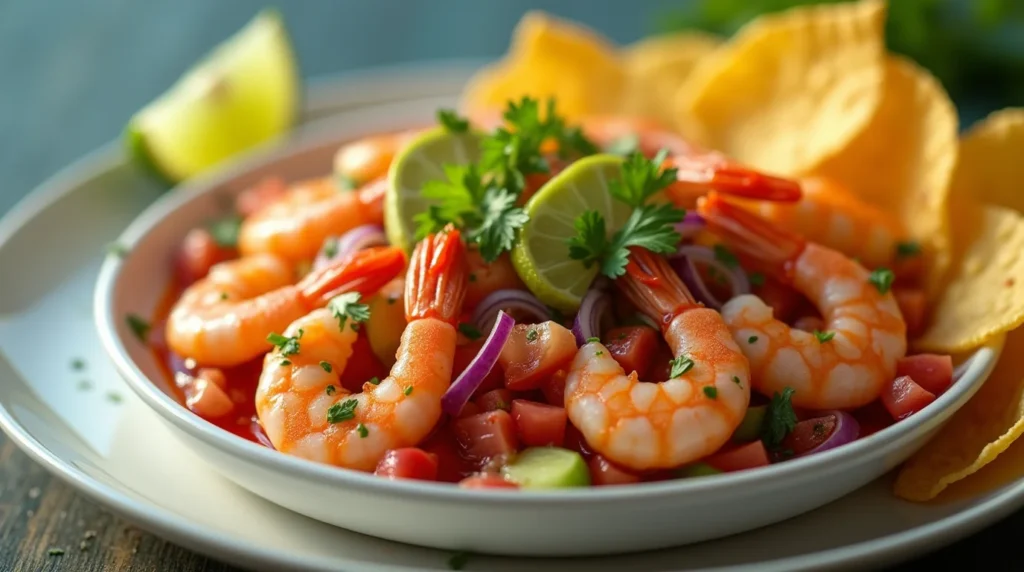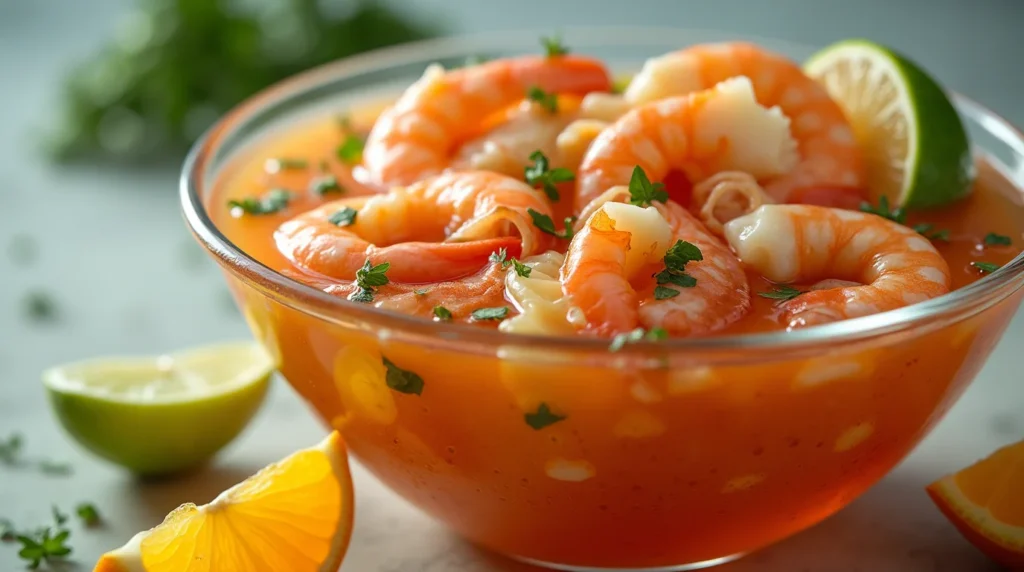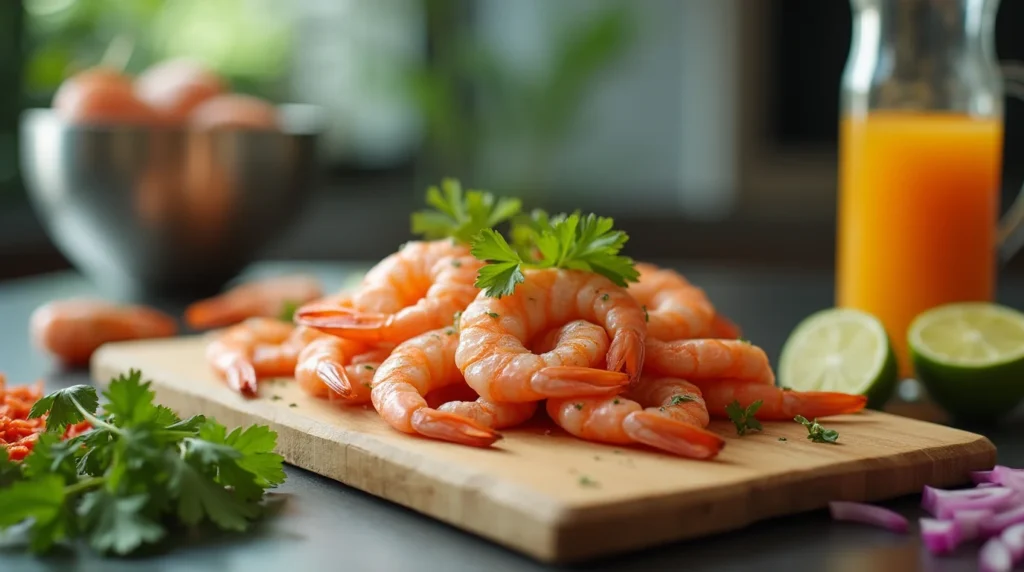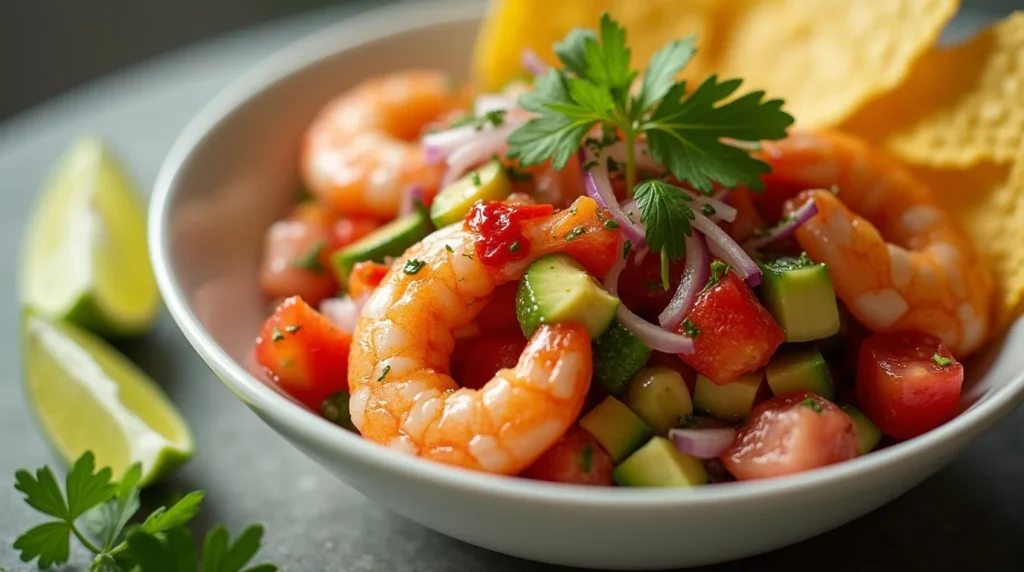
How to Make Perfect Ceviche de Camarones at Home!
Share this recipe
Every bite of ceviche de camarones evokes the vibrant coastal flavors that make this dish so special. My first taste of this zesty shrimp ceviche in Peru was unforgettable. The mix of bright citrus, fresh seafood, and crisp veggies captures the essence of Latin American cuisine, bringing a refreshing and flavorful experience any time of the year.
Ceviche de camarones is more than a recipe; it’s a celebration of fresh ingredients and traditional cooking. This refreshing dish balances flavors perfectly, making your home cooking shine.
Recipe Details:
Serving Size: 4 servings | Prep Time: 20 minutes | Cook Time: 10 minutes (marination time) | Total Time: 30 minutes
Ingredients per Serving
- 1/2 pound fresh shrimp
- 1/2 cup fresh lime juice
- 1/4 red onion, finely diced
- 1 jalapeño, minced
- tablespoons cilantro
- Salt and pepper to taste
Nutritional Facts (per serving)
- Calories: 120
- Protein: 15g
- Carbs: 5g
- Fat: 3g
- Fiber: 1g
- Sodium: 250mg
- Sugar: 2g
Key Takeaways
- Ceviche de camarones is a vibrant, no-cook seafood dish
- Fresh ingredients are crucial for authentic flavor
- Proper shrimp preparation ensures food safety
- Citrus juice “cooks” the raw shrimp
- Perfect for summer gatherings and light meals
The Art and History of Ceviche de Camarones
Explore the colorful world of peruvian cuisine, where ceviche de camarones is a true masterpiece. It has captivated food lovers for generations. This dish is more than a recipe; it’s a cultural celebration that honors latin american food traditions.
The tale of ceviche starts in ancient Peru. Coastal communities there first came up with this amazing seafood method. Fishermen used citrus fruits to “cook” their catch without heat.
Origins in Latin American Cuisine
Ceviche has its roots in the rich culinary history of Latin America. It comes from:
- Pre-Columbian Peruvian coastal civilizations
- Inca preservation techniques
- Spanish culinary influences
Cultural Significance of Shrimp Ceviche
In peruvian cuisine, ceviche is a national treasure. Families come together to make and enjoy this seafood delight. They celebrate their cultural heritage with every bite.
Regional Variations
Every Latin American country has its own version of ceviche de camarones. From Peru’s classic to Ecuador’s zesty, it shows the amazing diversity in latin american food traditions.
“Ceviche is not just food; it’s a celebration of ocean, culture, and tradition.” – Peruvian Chef
Essential Ingredients for Authentic Shrimp Ceviche
Making ceviche de camarones is all about the right ingredients. They must work together to create a burst of flavor. The base of this shrimp recipe starts with the freshest parts.
Your main ingredients are:
- Fresh raw shrimp – the star of your seafood dish
- Lime juice for citrus marinade
- Red onions, finely diced
- Fresh cilantro
- Tomatoes
- Jalapeño or serrano peppers
For the best shrimp ceviche, use top-quality, sushi-grade shrimp. They should be firm, smell like the ocean, and be white or slightly pink. Stay away from shrimp that are off-color or smell too fishy.
Pro tip: Always buy shrimp from a trusted fishmonger who ensures freshness and proper handling.
Every ingredient is important for the ceviche’s taste. Lime juice adds a tangy flavor and “cooks” the shrimp. This makes the dish safe and refreshing.
Selecting and Preparing Fresh Shrimp for Ceviche
Making the perfect lime-cured shrimp for ceviche begins with choosing the best seafood. The quality of your shrimp is key to a great dish. So, picking the right shrimp is very important.
Choosing the Right Type of Shrimp
Not all shrimp are good for ceviche. Look for:
- Wild-caught Pacific or Gulf shrimp
- Fresh, never frozen varieties
- Medium-sized shrimp (preferably 16-20 count)
“The fresher the shrimp, the more delicious your ceviche will be.” – Coastal Cuisine Expert
Cleaning and Preparation Techniques
Proper preparation is crucial for safe and tasty lime-cured shrimp. Here’s what to do:
- Rinse shrimp thoroughly under cold water
- Remove shell and tail
- Devein carefully using a small paring knife
- Pat dry with paper towels
Quality and Size Considerations
When picking shrimp for your marinade, look for:
- Firm to the touch
- Bright, translucent appearance
- No strong fishy odor
- Consistent size for even marination
By following these steps, your ceviche de camarones will be safe and delicious.
The Perfect Citrus Marinade Recipe

Making the perfect citrus marinade is key to great ceviche de camarones. This method turns raw shrimp into a tasty dish. The marinade’s quality affects the dish’s texture, taste, and safety.
Choosing the right citrus fruits is crucial. Fresh lime juice is the main ingredient. But, you can also try other citrus fruits like lemon, orange, and grapefruit.
- Lime juice (primary acidic base)
- Lemon juice for brightness
- Orange juice for subtle sweetness
- Grapefruit juice for tangy complexity
When making your marinade, keep these points in mind:
- Use freshly squeezed citrus juice for the best flavor
- Make sure the juice covers all the shrimp
- Use 1 cup of citrus juice for every pound of shrimp
“The magic of ceviche happens when acid meets protein” – Chef Maria Rodriguez
The marination process takes 15-30 minutes. In this time, the citrus acid “cooks” the shrimp. It changes its texture and color. Adding salt, garlic, and chili peppers can make the marinade even better.
The quality of your citrus and its acidity are very important. They greatly affect the taste of your seafood. Always use the freshest ingredients for the best ceviche.
Step-by-Step Guide to Making Ceviche de Camarones
Making shrimp ceviche is all about precision and using fresh ingredients. This dish turns raw shrimp into a tasty meal with citrus juice. Follow these steps to make a ceviche de camarones that everyone will love.
First, gather all your ingredients for a smooth prep. Here’s what you need for your shrimp ceviche:
- Fresh, high-quality raw shrimp
- Fresh lime juice
- Red onion
- Cilantro
- Salt and pepper
Preparing the Base Mixture
Start by cleaning and deveining your shrimp. Cut them into small pieces for even marination. Put the chopped shrimp in a glass or ceramic bowl to start the ceviche de camarones process.
Marination Magic
The marination is key for perfect shrimp ceviche. Pour fresh lime juice over the shrimp, making sure they’re fully covered. The citrus will “cook” the shrimp through denaturation. Let it sit for 15-20 minutes, stirring now and then.
Final Touches
When the shrimp looks cooked, add chopped red onion, cilantro, and season with salt and pepper. Mix gently to mix all flavors. Your homemade ceviche de camarones is now ready to serve chilled and enjoy!
Safety Tips for Preparing Raw Shrimp Ceviche

When making ceviche, it’s important to focus on food safety. Raw shrimp needs special care to avoid foodborne illnesses. This ensures your ceviche is safe to eat.
First, choose the freshest shrimp you can find. They should be firm and look clear. Make sure they smell like the sea, not fishy.
- Purchase shrimp from reputable seafood markets or trusted suppliers
- Keep shrimp refrigerated at 40°F or below before preparation
- Use clean, sanitized cutting boards and utensils
- Wash hands thoroughly before and after handling raw seafood
The citrus juice in your ceviche is key to safety. Lime or lemon juice “cooks” the shrimp by changing proteins. But, it doesn’t get rid of all bacteria. To stay safe:
- Use fresh citrus juice with high acidity
- Marinate shrimp for at least 15-20 minutes
- Consider using sushi-grade or previously frozen shrimp
Some people should avoid raw seafood. This includes those with weak immune systems, pregnant women, and young kids. If you’re unsure, cook the shrimp a bit before marinating.
Traditional Garnishes and Serving Suggestions
Presenting ceviche de camarones is an art in Peruvian cuisine. It turns a simple seafood dish into a masterpiece. The right garnishes and serving techniques can make your Latin American food experience unforgettable.
When serving this classic dish, consider these traditional accompaniments. They will make your ceviche truly authentic:
- Crispy corn kernels (cancha)
- Thinly sliced red onions
- Fresh cilantro leaves
- Sliced sweet potato
- Lettuce leaves for garnish
Plating Techniques to Impress
Your presentation should highlight the vibrant colors and fresh ingredients. Use white plates to create contrast. This showcases the colorful shrimp and vegetables.
Create height by layering ingredients. Use garnishes to add visual interest.
Serving Temperature Guidelines
Temperature is key in Peruvian cuisine. Serve your ceviche de camarones immediately after preparation. Keep it chilled at around 40°F.
This ensures the shrimp remains fresh and the flavors are at their peak. Avoid leaving the dish at room temperature for extended periods.
Pro tip: Serve in chilled ceramic or glass dishes. This maintains the ideal temperature and enhances the dining experience of this beloved Latin American food classic.
Common Mistakes to Avoid When Making Shrimp Ceviche

Making the perfect shrimp ceviche needs careful steps and technique. Many home cooks accidentally ruin their dish with big mistakes during prep.
When working with lime-cured shrimp, several key mistakes can ruin your ceviche’s quality and safety:
- Using low-quality or previously frozen shrimp
- Incorrect shrimp size and cut
- Over-marinating the seafood
- Miscalculating citrus-to-shrimp ratios
The biggest mistake is picking the wrong shrimp. You need fresh, high-quality seafood that’s firm. Choose medium-sized, raw shrimp that are translucent and smell clean. Stay away from any shrimp that look off or smell too fishy.
How long you marinate the shrimp is also key. Marinating too long can make the shrimp tough and rubbery. Aim for 15-30 minutes for the best ceviche texture.
- 15 minutes: Slightly firm texture
- 30 minutes: Fully cured consistency
- Over 45 minutes: Risk of becoming tough
Another big mistake is not getting the right mix of ingredients. Your citrus marinade should cover all the shrimp. This ensures even curing and the best flavor.
Remember: Precision is key in crafting authentic, delicious marinated shrimp ceviche!
Storing and Serving Leftover Ceviche
Enjoying your citrus-cured seafood dish doesn’t end with the first serving. Proper storage can help you preserve the delicate flavors of your shrimp ceviche while maintaining food safety.
When handling leftover ceviche, follow these critical guidelines:
- Refrigerate immediately after serving
- Store in an airtight container
- Consume within 24-48 hours
Your seafood dish requires careful handling to prevent bacterial growth. The citrus marinade helps preserve the shrimp, but refrigeration is key to maintaining its quality.
“Fresh is best, but smart storage can extend your ceviche’s enjoyment” – Culinary Experts
To refresh leftover ceviche, try these tips:
- Drain excess liquid before serving
- Add fresh chopped herbs
- Squeeze additional lime juice
Remember that citrus-cured seafood is most delicious when consumed quickly. While refrigeration helps, the texture and flavor peak within the first day of preparation.
Always trust your senses. If the ceviche smells off or looks discolored, it’s best to discard it to ensure your safety.
Pairing Your Ceviche with Drinks and Sides
Enhancing your ceviche de camarones experience is more than just the dish. In Peruvian cuisine, choosing the right drink and sides can make a meal unforgettable. It’s a journey through Latin American food traditions.
Beverage Recommendations
For a true taste, try Pisco Sour, Peru’s national cocktail. It matches the ceviche’s bright citrus flavors. If wine is your choice, a crisp sauvignon blanc is perfect. It cuts through the tangy flavors with its acidity.
Complementary Side Dishes
Traditional Latin American food pairs ceviche with sweet potato slices, choclo (large-kernel corn), and cancha (toasted corn nuts). These sides offer texture and balance the seafood’s flavor. For a twist, add a light quinoa salad or plantain chips.
Don’t forget, presentation is key. Arrange your sides nicely and serve the ceviche chilled. This will make your meal the most authentic and refreshing.
If you love the bold flavors of Ceviche de Camarones, you might also enjoy Camarones a la Diabla—a spicy and flavorful Mexican shrimp dish that brings heat and richness to your seafood experience. Unlike the citrusy freshness of ceviche, Camarones a la Diabla features shrimp cooked in a fiery red chili sauce, creating a bold contrast that seafood lovers will appreciate. Try both dishes and explore the diverse flavors of Latin American shrimp recipes!









